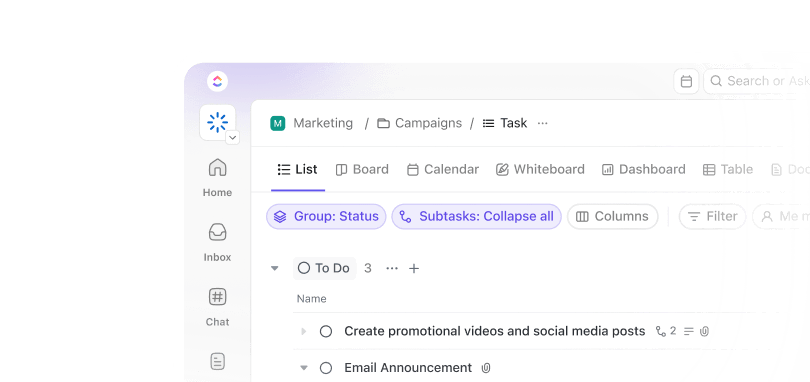Your work calendar shouldn’t feel like a ticking time bomb! Yet, here you are, juggling double bookings, last-minute rescheduling, and meetings that eat up your entire day. It’s exhausting, right?
Turns out, it’s also dangerous. The World Health Organization warns that unmanaged stress from chaotic work schedules can seriously impact your health.
But when done right, effective scheduling keeps teams organized, reduces stress, and (finally) allows you to prioritize your work correctly.
Let’s break down the most common work schedule conflicts and, more importantly, how to fix them before they wreck your sanity.
Common Scheduling Issues At Work And How to Tackle Them
⏰ 60-Second Summary
- Poor scheduling leads to burnout, missed deadlines, and low team morale
- Common scheduling issues at work include last-minute changes, overlapping meetings, and uneven workload distribution
- Businesses struggle with scheduling across different time zones and remote work setups
- A clear scheduling strategy prevents chaos and keeps workflows balanced
- Smart planning, automation, and flexibility help teams stay productive
- Eliminating unnecessary meetings frees up time for deep work
- simplifies scheduling with its AI-powered Calendar, workload management, and smart insights
- Shift and team schedule templates help organize shifts, track availability, and reduce conflicts
Common Employee Scheduling Issues
A well-planned schedule should make work smoother and not stressful. However, in many workplaces, scheduling problems lead to burnout, confusion, and missed deadlines.
Here’s a closer look at the typical scheduling conflicts employees face.
1. Last-minute changes and lack of planning
It’s Friday evening, and Sarah, a retail store manager, finally settles in for the weekend. Just as she’s about to relax, she gets a frantic text—two employees have taken time off, and no backup plan is in place. She scrambles to find replacements, but most of her team is unavailable.
Last-minute changes like these are common in industries with unpredictable demands. Employees feel blindsided, morale drops, and businesses suffer from inefficient operations without a structured approach.
2. Overlapping meetings and conflicting priorities
👀 Did You Know? Over 11 million meetings happen daily in the U.S.—55 million a week and over a billion a year!
Overlapping meetings is a common scheduling conflict, forcing employees to skip one discussion or juggle two at once, often multitasking through both.
The result? Important decisions are missed, tasks get delayed, and employees feel overwhelmed by constant calendar conflicts.
📮 Insight: Our meeting effectiveness survey data shows that 25% of meetings involve 8 or more participants on average. We also found that an average meeting lasts approximately 51 minutes. These large meetings can result in at least 6 to 8 hours of collective meeting time spent per week at an organizational level.
What if you could cut it down? transforms how teams communicate! Instead of lengthy meetings, collaborate directly within tasks using comments, attachments, voice notes, video clips, and more—in one place.
💫 Real Results: STANLEY Security’s global teams already saved 8+ hours weekly on meetings and updates with our everything app for work!
3. Uneven workload distribution
In the same team, two employees can have wildly different experiences:
- Emma, a senior designer, is drowning in unfinished projects, staying up late every night to meet deadlines
- James, a junior designer, spends half his day waiting for new assignments
This imbalance leads to burnout for some and disengagement for others. Overloaded employees start making mistakes, while those with less work feel undervalued. Over time, resentment builds, and productivity suffers.
4. Lack of transparency and poor communication
A McKinsey report on the Great Resignation found that 19 million knowledge workers quit their jobs due to poor internal communication and a lack of meaningful interactions. When employees feel out of the loop, frustration builds—and scheduling is no exception.
Imagine this: A software development company launches a big project but fails to update teams on changes in the project schedule.
The design team thinks they have two more weeks to finalize visuals—until they learn the deadline has already passed. Cue last-minute panic, rushed work, and a subpar end product.
When schedules and deadlines aren’t clearly communicated, teams get stuck in a cycle of confusion, missed expectations, and unnecessary stress.
5. Different time zones and remote work challenges
Manager: “Let’s schedule a quick call for 3 PM EST.”
Remote team member, in Sydney: “Uh… that’s 5 AM for me.”
Sound familiar? Time zone struggles are a constant headache for global teams. Scheduling across multiple time zones often leads to employees attending meetings at odd hours or missing important discussions entirely.
When remote teams aren’t considered in scheduling decisions, collaboration becomes messy, and work-life balance suffers.
6. Unclear deadlines and task dependencies
When deadlines are unclear, projects start to unravel:
- A marketing team waits on content from the writing team, but they’re never given a specific deadline
- The writers assume they have more time and prioritize other projects
- The marketing launch gets delayed, leading to stress and last-minute scrambling
Task dependencies mean that one team’s delay can disrupt an entire workflow. Without clear deadlines, bottlenecks form, productivity slows down, and projects fall behind.
7. Shift scheduling conflicts
Retail and hospitality workers often face unpredictable shifts that disrupt their work-life balance. A well-known lawsuit against McDonald’s highlighted issues with erratic night shift schedules, unpaid overtime, and missed breaks, making it difficult for employees to manage their health, finances, and personal lives.
Shift conflicts arise when schedules are posted too late, employees aren’t given enough notice, or managers make last-minute adjustments without consulting their team.
The result? Higher employee turnover rates, frustrated staff, and inconsistent service quality.
8. Too many meetings, not enough focus time
The ideal workday would include employees starting their day with a plan, dedicating time to deep work, and using meetings only when necessary.
However, meetings fill every available time slot, in reality, leaving no room for actual work. Employees jump from call to call, multitasking during discussions and struggling to complete tasks on time.
👀 Did You Know? According to Microsoft’s Work Trend Index, corporate employees spend 252% more time in meetings now than they did before 2020.
More meetings don’t always mean better productivity, but it definitely results in more meeting conflicts.
📮 Insight: According to our meeting effectiveness survey, 12% of respondents find meetings overcrowded, 17% say they run too long, and 10% believe they’re mostly unnecessary.
In another survey, 70% of the respondents confessed that they would happily send a substitute or a proxy to the meetings if they could.
’s integrated AI Notetaker can be your perfect meeting proxy! Let AI capture every key point, decision, and action item while you focus on higher-value work. With automatic meeting summaries and task creation assisted by Brain, you’ll never miss critical information—even when you can’t attend a meeting.
💫 Real Results: Teams using ’s meeting management features report a whopping 50% reduction in unnecessary conversations and meetings!
9. No flexibility for work-life balance
Meet David. He’s a working parent juggling client calls, project deadlines, and school drop-offs. His rigid 9-to-5 schedule doesn’t account for real-life responsibilities, leaving him constantly stressed.
Rigid schedules don’t care if daycare pickup runs late or a forgotten personal commitment pops up. Without flexibility, stress piles up, job satisfaction tanks, and burnout sneaks in before you even realize it.
10. Not being prepared for system failures
Scheduling systems are great—until they crash. Without a backup plan, businesses may be left scrambling, leading to missed shifts, project delays, and frustrated employees.
Take Southwest Airlines’ infamous meltdown in December 2022. A winter storm hit, but while other airlines recovered quickly, Southwest’s outdated crew scheduling system collapsed under pressure. Pilots and flight attendants were stranded in the wrong cities, and thousands of flights were canceled, causing a ripple effect of chaos.
Relying too much on automated scheduling without a contingency plan is unwise. When systems fail, and there’s no manual backup process, businesses can face significant disruptions that take days (or even weeks) to fix.
Now that you know the most frequent causes behind scheduling issues, let’s figure out how to solve them.
Effective Strategies to Overcome Scheduling Issues at Work
Tired of last-minute scrambles and back-to-back meetings? A few smart fixes can turn scheduling issues at work into a smooth, productive routine. Here’s how to make it happen:
Implementing clear scheduling policies
If scheduling feels like a guessing game, that’s a red flag. Effective workforce management means everyone should know when they’re working, who’s on call, and how to handle swaps.
🎯 How do you fix it? Labor laws in many countries set rules for employee work hours, overtime, leave management, and shift scheduling.
Employers should follow these while also creating clear internal policies for meetings, shift changes, and time-off requests. Keep them easy to find, easy to follow, and impossible to ignore.
Prioritizing tasks and meetings
Without a solid system, schedules become a mess of endless meetings and scattered tasks. That’s where a work management tool comes in.
—the everything app for work—does it all. From scheduling and task prioritization to automating workflows, it helps your teams stay organized without chaos. It also offers various time management templates to simplify scheduling.
One of these is the Schedule Blocking Template—designed to organize tasks, meetings, and deep work sessions into structured time blocks.
Here’s what’s inside:
- Scheduling Form View: Captures task details and priorities in a single form, automatically creating Tasks
- Activities List View: Groups tasks by category, availability, whereabouts, and type for easy tracking
- Daily, Weekly, and Monthly Calendar Views: Provides a clear snapshot of schedules to plan ahead
- Location Map View: Pins exact addresses for meetings, site visits, or any location-based tasks
- Custom Fields: Includes dropdown menus for availability, category, and type, plus a location field for precise planning
💡 Pro Tip: Struggling to decide what needs your attention first? The best way to cut through the chaos is to set your priorities straight. The Prioritization Matrix Template helps sort tasks by urgency and importance, so you can focus on what truly matters.
Most importantly, if an update works as an email, make it one. But if a meeting is necessary, keep it short and purposeful and only invite those who actually need to be there.
Encouraging team collaboration and flexibility
Rigid schedules and siloed work slow teams down, but a little flexibility goes a long way.
70% of employees believe better collaboration could significantly boost productivity and save time.
When teams communicate openly and adapt to changing priorities, work moves more smoothly, and deadlines don’t feel like constant fire drills. To achieve this:
- Use shared calendars to keep everyone informed without endless check-ins (we’ll discuss how Calendar can be useful here!)
- Rely on task management tools such as Tasks for real-time updates and clear ownership of work to improve workload distribution in your team
- Encourage async employee communication with platforms like Chat, so teams are able to collaborate without disrupting deep work
- Set clear guidelines for availability, shift swaps, and workload balancing
- Allow flexible scheduling while ensuring accountability to maintain productivity and reduce stress
After all, collaboration isn’t just about working together; it’s also about working smarter.
📮 Insight: About 41% of professionals prefer instant messaging for team communication. Although it offers quick and efficient exchanges, messages are often spread across multiple channels, threads, or direct messages, making it harder to retrieve information later.
With an integrated solution like Chat, your chat threads are mapped to specific projects and tasks, keeping your conversations in context and readily available.
Regularly reviewing and adjusting schedules
Even the best schedules need fine-tuning. Without regular check-ins, they can quickly become outdated and inefficient. A smarter approach? Make schedule reviews a habit.
You can start with these steps:
- Set a review cycle: Weekly or biweekly check-ins help catch conflicts early
- Listen to your team: Feedback reveals what’s working and what needs fixing
- Analyze trends: Look for patterns in workload distribution and productivity
- Automate where possible: Smart scheduling tools reduce manual adjustments
- Stay adaptable: A little flexibility prevents last-minute chaos
Managing schedules doesn’t have to be a guessing game. Zeroing in on and deploying shift management software may be the simplest way to resolve many of your issues.
Using scheduling software for automation
Keeping schedules organized manually is a never-ending struggle, which can lead to missed deadlines, double-booked shifts, and constant rescheduling. takes the hassle out of scheduling with its countless features designed to make your life easier.
Calendar elevates scheduling beyond basic time management by seamlessly blending calendar functions with task prioritization:
- Schedule meetings with team members using the ‘Meet with’ option in the dock at the bottom of the Calendar. Simply select their name, and instantly displays mutual availability
- Block dedicated focus time for priority tasks by dragging them directly onto your calendar or let the AI automatically schedule them based on time estimates


- With two-way Google Calendar sync, integrated meeting notes, and the ability to join meetings directly from , this tool transforms scheduling from isolated time blocks into a comprehensive productivity system that connects your events to actual deliverables
Why struggle with perfecting schedules manually when Automations can do it for you? From auto-assigning shifts to sending deadline reminders, you can build intelligent workflows to handle the busy work.


And, if you want to plan team shifts, assign roles, and track attendance, without the usual scheduling headaches, ’s work schedule templates come in handy.
The Shift Schedule Template, for example, makes it easier to manage rotational shifts and avoid conflicts with enhanced visibility.
Here’s what the template has for you:
- Shift Schedule Calendar View: A color-coded calendar to visualize shift timings, assign team members, and automate recurring shifts
- Task assignment: Easily assign shifts to individuals or teams with a few clicks, ensuring everyone knows their schedule
- List of Activities View: Tracks all shift roles and capacity needs, helping project managers see workforce availability at a glance
- Absent people field: Flags no-shows and tracks attendance trends
- Reason for absence field: Logs absence details for better workforce planning and adjustments
Another great way to keep schedules on track is with the Team Schedule Template. It makes it easy to see who’s available, assign shifts without gaps, and keep projects running smoothly.
That’s not all! acts as an employee management software by offering so much more for smarter scheduling, like:
- Timeline View: Plan predictable work hours and avoid scheduling overlaps
- Time Tracking and reporting: Monitor work hours and analyze productivity
- Integrations: Sync with other scheduling tools like Calendly or Google Calendar for a smooth workflow
- Brain: Automate scheduling, draft meeting agendas, and generate task summaries with AI-powered efficiency


🧠 Fun Fact: The idea of the five-day workweek became mainstream thanks to Henry Ford in 1926. He did it to boost productivity, not just give workers a break. Companies worldwide are now experimenting with 4-day workweeks, proving that sometimes less is more!
Adopting Best Practices for Scheduling in Various Industries
Smart scheduling practices look different across industries. What works for a retail store won’t cut it for a hospital or factory. Let’s break down proven scheduling best practices for creating rosters employees will love in different sectors.
Retail: Making customer traffic work for you
Retail scheduling success starts with understanding foot traffic patterns and what employees actually need. With 54% of managers admitting leadership is out of touch with employee expectations, it’s clear that balancing business needs with staff well-being is just as crucial.
Here’s how retail managers can strike the right balance:
- Use Point of Sale (POS) data to predict peak hours and ensure adequate staffing accordingly
- Plan for seasonal rushes and special events in advance using timesheet templates
- Consider employee scheduling preferences to keep morale high
Healthcare: When lives are on the line
Healthcare scheduling needs to run like a well-oiled machine. A single gap can throw off everything, from routine checkups to urgent cases. Plus, no-shows in existing schedules don’t just waste appointment slots; they drain time and resources, leaving staff scrambling to adjust.
A more thoughtful approach includes:
- Cross-training staff on scheduling systems and time-blocking apps to avoid confusion
- Dynamic coverage for sudden absences so shifts stay balanced
- Using a 2-2-3 work schedule, where staff work two days on, two days off, then three days on. This ensures better employee availability and prevents burnout
- Combining innovative tools with human outreach also makes scheduling more effective
A study by NIH showed that predictive phone outreach, in tandem with standard automation, can cut no-shows, making schedules more efficient and reducing wasted time.
Work Smarter, Not Harder with
If managed well, every meeting, shift, and deadline is an investment in productivity. However, without the right tools, the scheduling process can feel more like an uphill task than a strategic advantage.
But is built for resolving scheduling conflicts! With powerful scheduling tools, automation, and customizable templates, managing shifts, meetings, and team availability becomes effortless. No more crossed wires, just a smarter way to organize your team’s time.
Ready to take control of your schedule? Try for free and keep your project management on track!


Everything you need to stay organized and get work done.













